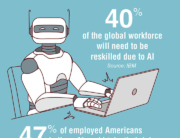Contingent workforce buyers and suppliers have always kept an eye on metrics, but now machine learning aims to automate and speed up the analysis of data.
Last November, Google announced its Cloud Jobs API, which uses machine learning to enable job-seekers to find jobs more easily. Meanwhile, a survey by CareerBuilder found that 55% of HR managers expect artificial intelligence to have a major impact on HR and employment in the next five years, and automation will be a “core function” of a future platform that could transform the staffing industry, Textkernel’s Jackub Zavrel said in a blog post in January. In addition, several firms in the contingent workforce space recently announced new services with machine learning.
“I do believe there’s somewhat of an arms race in how to best leverage the ability of machine learning,” says Tom Tisdale, VP, talent supply chain analytics at the KellyOCG Centers of Excellence.
Machine learning was already around, but it has become much less expensive in terms of the technology infrastructure because of the cloud and open systems, Tisdale says. “We have new ways to do that and it’s all in the cloud and we don’t have to invest in large scale applications and a data center to leverage machine learning. … Technology is really proving a much lower cost investment up front to start.” In addition, there’s more sophistication now and less of a learning curve.
It’s Real
“Machine learning is going on,” says Brian Delle Donne, president of Talent Tech Labs. “It is legitimately here and there are real instances of it working and working very well.”
Talent Tech Labs’ work includes serving as an incubator to new HR tools with an aim toward improving the state of recruitment by investigating emerging technologies. It began as the research and development hub of staffing provider Mitchell Martin Inc. Today it’s reviewing 30 to 35 startups per month.
Delle Donne describes machine learning as part of artificial intelligence, which he explains by distinguishing AI from simple intelligent automation. It’s truly AI when machine learning, deep learning and neural networks are leveraged. Here are the aspects of AI:
- Intelligent automation refers to automating a set of instructions that are followed by rote. For example, an automated answering system on a customer service line. Depending on the caller’s response, the system follows a set of instructions to send them down specific paths to what the caller needs.
- Machine learning takes this further by refining questions and going to the next level of abstraction. Outcomes are no longer just limited to canned responses such as in the phone tree example. The appropriate path to the outcomes is based on analysis of patterns in previous answers and results. Delle Donne cites as an example a tool that optimizes the wording in job descriptions to encourage more diversity candidates to apply. The tool looks at some 50 million job description compared to who was hired.
- Deep learning refers to the number of layers of data that are included in coming up with insights. “The deeper it is, the more refined,” Delle Donne says.
- Neural networks refers to the combination of software, hardware and data sets in the cloud that enable AI to take place. “For machine learning to be effective, you really need large amounts of data,” Delle Donne says. “The more data that you put through these machine learning algorithms, the better the machine learning.”
AI itself is gathering steam. Recently, AI beat the top-ranked player of Go, which is considered the most demanding strategy game in the world.
And recently, there have been new announcements related to machine learning.
Entering the Playing Field
Vendor management system provider SAP Fieldglass announced a new service called Live Insights that uses machine learning to speed up and further automate how data on companies’ external workforces are analyzed.
SAP Fieldglass President Rob Brimm says machine learning is used to normalize data to ensure that users are comparing like for like. Machine learning is also used to find patterns in data using metrics such as time-to-fill, wage rates and seasonality. The service can also allow buyers to test “what if?” scenarios using predictive analytics.
Such analytics could have been done in the past, but it would have been a labor-intensive process, Brimm says. The new service brings more speed and automates the process of data normalization.
“From a buyer perspective, they are able to get real-time, live feedback as to various benchmark dimensions,” Brimm says. The No. 1 impact is to speed timely hiring decisions. For staffing suppliers, the impact is more transparency to past performance and a leveling of the playing field, he says.
VMS provider Beeline also announced its “Beeline Assistant,” which aims to update its user interface and use automatic speech recognition and natural language understanding to let users conduct common tasks. Its aim is to make transactions easier for users by allowing natural and intuitive interactions regardless of device from which users are connecting. Beeline announced Beeline Assistant in April and says it’s the first VMS to bring such a product to market.
In another recent example, Allegis Global Solutions and Brightfield Strategies announced a partnership focused on services procurement — such as statement-of-work contracts — to use Brightfield’s machine learning and natural language processing capabilities and Allegis Global Solutions’ ACUMEN Workforce Intelligence domain expertise and data to create new and innovative products.
It will include analyzing “structured” and “unstructured” data by using machine learning. Structured data are data whose values are anticipated, as though they were selected through a drop-down.
“Structured data is organized in a repeatable way and can easily be queried or managed in common database formats,” says Neil McGrail, director, global procurement, at Allegis Global Solutions. “From a procurement perspective, common examples would include items such as purchase orders or vendor master data would fall into this category. Unstructured data is basically the opposite and consists of text and other information that is not laid out in a structured format.”
Analyzing unstructured data, essentially, required a manual audit in the past, but it can be done more quickly now with technology, McGrail says.
“Natural language processing provides new levels of efficiency for managing unstructured data, and machine learning provides improved analysis capabilities which increase in accuracy and reliability as more data is processed,” he says. “It gets to the point where you can be predictive in looking forward to what kind of project costs will be incurred bases on spend patterns.”
Jason Ezratty, co-founder and president of Brightfield Strategies, describes machine learning as “a massive statistical study about how one dimension impacts others across every single dimension — but with the speed of a computer.”
To structure the unstructured data, computer programs must look at numerous dimensions to find patterns in the data. For example, to calculate a bill rate there are some 50 dimensions that include location, how long a person has been in the industry, skill attributes within a job title and more.
The number of dimensions creates complexity. A simple chart might contain two or three. However, machine learning can take into account millions of dimensions to answer complicated contingent workforce questions. For example, it could be used to predict whether a worker will get a good performance rating or forecast whether there will be a dip in price over the next six months.
With the bill rates example, Ezratty says Brightfield’s Talent Data Exchange (TDX) can predict the bill rate a buyer will pay for a given requisition with more than 95% reliability.
Machine learning could also spot where structured data doesn’t match unstructured data.
“Our clients want increased visibility and control over their services procurement contracts and spend data,” says Steve Schumacher senior VP, global product leader, at Allegis Global Solutions. “This platform will empower our program leaders and analysts with untapped data by leveraging Brightfield’s innovative natural language processing and machine learning capabilities.”
Of course, enabling machine learning to take place involves a lot of work.
When structuring data, computers use numerous algorithms, but humans must still figure out the relevant inputs. And Ezratty says that while it doesn’t take long to build a model that can deliver some value, it takes time to build a process that will take into account all the intense variance in data for the most accurate predictions.
Machine learning is also one part of a trend on increased focus on increased use of analytics.
“Not surprisingly, the investments in analytics, benchmarking and predictive demand management we witnessed in 2016 have continued into 2017,” says John Nurthen, executive director of global research at Staffing Industry Analysts. “Staffing firms, MSPs and VMSs all recognize the merit of developing more reliable and more sophisticated analytics and we expect this to continue, driven by increased appetite to evaluate cost and value across different worker types (temporary versus permanent versus independent contractor, etc.) with greater data aggregation across multiple client bases for benchmarking.”
KellyOCG’s Tisdale says companies are also using data not just for process efficiency but for redesigning their businesses. “We are a global, interconnected world of work. We are, for the first time, able to look at assignments within the firm and ask where and by whom should these assignments and components of these assignments be accomplished in order to drive sustainable profitability.” For example, is there more margin in having another company recruit for a position instead of a Kelly recruiter or source a certain niche or [metropolitan statistical area]? Or should they divest to a strategic partner an entire book of business?
Data analysis should include companies comparing not just their internal data but from other firms.
However, the industry does not have metrics right now that it can easily benchmark and compare itself to, he says. “We can’t define to a customer that says if you’re looking to a legal secretary, time to hire, cost per hire and what supply chain. … As an industry, we can’t even agree to ubiquitous standard calculations (e.g., time to hire or even what is the definition of a hire).”







